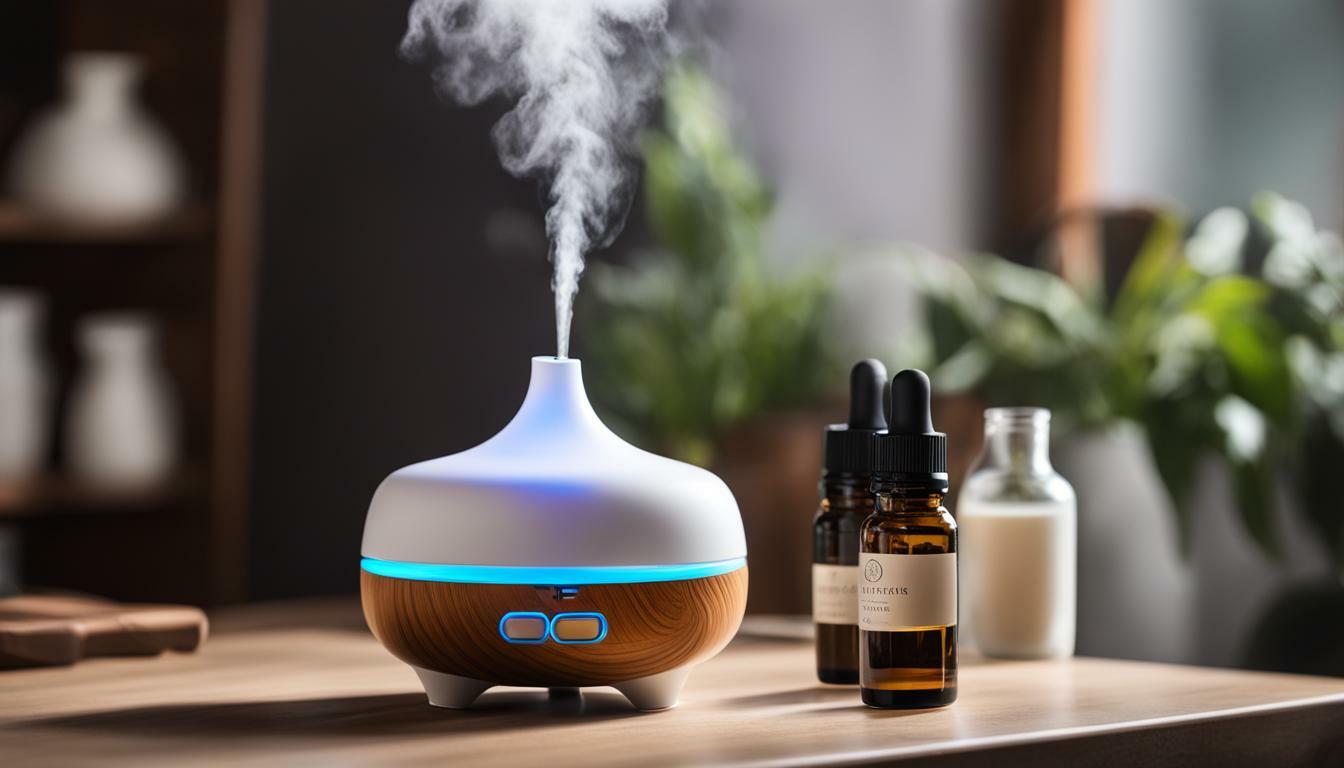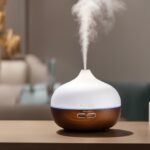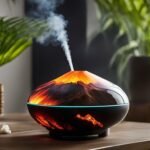
If you’re wondering why your essential oil diffuser is not misting, there could be a few reasons behind this issue. In this section, I will explore the possible causes and provide expert-backed solutions to help you optimize your diffuser’s performance.
One of the first things to check is the water level in your diffuser. If the water is too full or too low, it can affect the quality and strength of the mist. Make sure to fill the water slightly below the maximum fill line for optimal performance.
The placement of your diffuser is also crucial. Ensure that it is placed on a hard, flat surface, as placing it on a soft surface like a towel can absorb the ultrasonic vibrations and impact the misting process.
Another factor to consider is the positioning of your diffuser in relation to air vents or fans. Placing the unit directly under an air vent or fan can disperse the mist and make it less noticeable. So, make sure your diffuser is positioned in a way that allows the mist to spread evenly throughout the room.
Using the right essential oils is essential for proper misting. It is recommended to use 100% pure essential oils rather than fragrance oils, as fragrance oils can void the warranty and may not work effectively in the diffuser. Stick to pure essential oils for the best results.
Regular cleaning and maintenance are also vital for optimal misting performance. Cleaning the diffuser regularly, using distilled white vinegar, and wiping around the ceramic diffusing disc can help remove any buildup that may be affecting the misting. Avoid getting water into the air vent opening and allow the unit to air dry for at least 48 hours to ensure it is completely dry before use.
If you have tried these troubleshooting steps and your diffuser is still not misting, there may be other factors at play. It could be due to the diffuser being out of water, overloading it with too much water or oil, using water with high mineral content, or the unit not being plugged in or switched on. Checking these factors and addressing them accordingly may resolve the issue.
If all else fails, it may be necessary to consult the manufacturer for further assistance or consider replacing the diffuser. Remember, proper troubleshooting and maintenance are key to enjoying the full benefits of your essential oil diffuser.
Check the Water Level
One possible reason why your essential oil diffuser is not misting is due to the water level. If the water is too full or too low, it can affect the strength of the mist. To ensure optimal performance, fill the water slightly below the max fill line. This allows enough water for the diffuser to generate a fine mist without overwhelming the unit.
Another important factor to consider is the placement of your diffuser. It is crucial to place it on a hard, flat surface. Placing the diffuser on a soft surface like a towel can absorb the ultrasonic vibrations and hinder the misting process. By ensuring a stable foundation, you allow the diffuser to function efficiently and emit a consistent mist.
In addition to water level and placement, it is important to verify that the unit is not positioned directly under an air vent or fan. This can disperse the mist and make it less noticeable. By avoiding direct exposure to air vents or fans, you can enhance the misting effect and fully experience the benefits of your essential oils.
| Common Reasons for Essential Oil Diffuser Not Misting |
|---|
| Water level too high or too low |
| Diffuser placed on a soft surface |
| Direct exposure to air vent or fan |
By addressing these potential issues with water level, placement, and ventilation, you can troubleshoot and optimize the misting performance of your essential oil diffuser. However, if the problem persists, it may be necessary to consult the manufacturer for further assistance or consider replacing the diffuser.
Placement and Ventilation
The placement of your essential oil diffuser can also play a role in its misting performance. To ensure optimal misting, it is important to place the diffuser on a hard, flat surface. Placing it on a soft surface like a towel or carpet can absorb the ultrasonic vibrations and affect the diffusion of the essential oils into the air.
In addition to the placement, you should also consider the proximity of the diffuser to air vents or fans. Positioning the diffuser directly under an air vent or fan can disperse the mist and make it less noticeable. To avoid this, choose a location away from any direct airflow sources. By finding the right spot for your diffuser, you can enhance the misting experience and ensure the essential oils are effectively dispersed into your space.
If necessary, you can use an h3 tag for a subheading when discussing a relevant topic within the placement and ventilation context.
| Common Placement and Ventilation Tips |
|---|
| Place diffuser on a hard, flat surface |
| Avoid placing diffuser directly under an air vent or fan |
| Choose a location away from direct airflow sources |
By following these placement and ventilation guidelines, you can optimize the misting performance of your essential oil diffuser and enjoy the full benefits of aromatherapy in your home or workspace.
Using the Right Essential Oils
The choice of essential oils you use in your diffuser can impact its misting performance. It is essential to use 100% pure essential oils to ensure proper functioning and avoid potential issues. Fragrance oils, although they may have a pleasing aroma, can void the warranty and may not work effectively in the diffuser. Opting for pure essential oils will help optimize your diffuser’s misting capabilities.
When selecting essential oils, make sure they are labeled as 100% pure and free from any synthetic additives. Pure essential oils are derived directly from plants and possess the natural properties that provide therapeutic benefits. They can disperse effectively in the diffuser, resulting in a consistent and satisfying misting experience.
Additionally, using pure essential oils promotes the longevity of your diffuser. These oils are less likely to cause clogs and buildup within the unit, ensuring its continued performance over time. By investing in high-quality essential oils, you are not only enhancing the aroma and atmosphere of your space, but also taking care of your diffuser for long-term use.
Cleaning and Maintenance
Proper cleaning and maintenance are crucial for resolving misting issues in your essential oil diffuser. If you’re experiencing difficulties with your diffuser not producing any mist, there are several steps you can take to troubleshoot and address the problem.
- Check the water level: Ensure that the water in your diffuser is not too full or too low. If it’s filled beyond the maximum fill line, it can impact the strength of the mist. Similarly, if the water level is too low, it may not generate enough vapor. It’s recommended to fill the water slightly below the max fill line to optimize misting performance.
- Verify diffuser placement: Make sure that your diffuser is placed on a hard, flat surface. Placing it on a soft surface like a towel can absorb the ultrasonic vibrations and hinder misting. Additionally, ensure that the diffuser is not positioned directly under an air vent or fan, as this can disperse the mist and make it less noticeable.
- Utilize 100% Pure Essential Oils: It’s important to use only 100% pure essential oils in your diffuser. Fragrance oils can void the warranty and may not work effectively, leading to reduced misting performance. Opt for high-quality essential oils to maximize the benefits and functionality of your diffuser.
To address the issue, cleaning your diffuser thoroughly is recommended. One effective method is to soak the diffuser overnight in distilled white vinegar. This helps dissolve any mineral deposits or residue that may be obstructing the diffuser’s functionality. After soaking, wipe around the ceramic diffusing disc with a cloth to remove any remaining buildup. Avoid getting water into the air vent opening to prevent further issues.
Air drying the unit for at least 48 hours after cleaning is essential to ensure no moisture remains. It’s crucial to keep water away from the vent opening, as it can damage the internal components and impact misting performance. Additionally, consider using distilled or filtered water for regular use to prevent mineral buildup and maintain optimal diffuser operation.
If the troubleshooting steps mentioned above do not resolve the misting issue, it’s advisable to contact the diffuser’s manufacturer for further assistance. They can provide specific guidance tailored to your diffuser model or determine if a replacement is necessary to restore proper misting functionality.
Conclusion
By following the troubleshooting steps and maintaining your essential oil diffuser, you can ensure it mists effectively and provides a delightful aromatherapy experience.
If your diffuser is not misting, there are several potential reasons to consider. Firstly, check the water level; if it is too full or too low, it can affect the strength of the mist. To optimize performance, fill the water slightly below the max fill line.
Furthermore, make sure your diffuser is placed on a hard, flat surface. Placing it on a soft surface like a towel can absorb ultrasonic vibrations and affect the misting. Also, verify that the unit is not positioned directly under an air vent or fan, as this can disperse the mist and make it less noticeable.
Additionally, using only 100% pure essential oils is crucial for optimal diffuser performance. Fragrance oils can void the warranty and may not work effectively in the diffuser. To enhance the longevity of your diffuser, it is recommended to clean it regularly. Soaking the diffuser overnight in distilled white vinegar and wiping around the ceramic diffusing disc can help remove any buildup. Ensure that no water enters the air vent opening and air dry the unit for at least 48 hours.
If these troubleshooting steps do not resolve the issue, it is advisable to consult the manufacturer for further assistance or consider replacing the diffuser. Remember, proper maintenance and care can prolong the lifespan of your essential oil diffuser and enhance your aromatherapy experience.
FAQ
Why is my essential oil diffuser not misting?
There can be several reasons why your essential oil diffuser is not producing any mist. Common issues include improper water level, incorrect placement, using the wrong essential oils, or the need for cleaning and maintenance.
How do I check the water level in my diffuser?
To check the water level, make sure the diffuser is unplugged and remove the lid or cover. Ensure that the water is slightly below the max fill line, neither too full nor too low.
What can affect the misting of my diffuser?
Placing the diffuser on a soft surface like a towel can absorb ultrasonic vibrations and hinder misting. Additionally, positioning the unit directly under an air vent or fan can disperse the mist and make it less noticeable.
Can I use any type of essential oils in my diffuser?
It is crucial to use only 100% pure essential oils in your diffuser. Fragrance oils can void the warranty and may not work effectively, resulting in no misting.
How do I clean my diffuser?
To clean the diffuser, soak it overnight in distilled white vinegar and wipe around the ceramic diffusing disc. Avoid getting water into the air vent opening. Air dry the unit for at least 48 hours, ensuring no water enters the vent opening. Regular cleaning helps prevent mineral buildup and maintains proper misting.
What are other common reasons for a diffuser not misting?
Other common reasons include the diffuser being out of water, overloading the unit with too much water or oil, using water with high mineral content, the unit not being plugged in or the switch being off, or the diffuser needing cleaning. Checking for clogs caused by essential oil or mineral buildup is also advisable.
What are some tips for cleaning the diffuser?
When cleaning the diffuser, use distilled or filtered water. Adding a small amount of dish soap can help clean the unit. Check for clogs caused by essential oil or mineral buildup, and carefully remove any obstructions.
What should I do if these troubleshooting steps do not resolve the issue?
If these steps do not resolve the issue, it is recommended to consult the manufacturer for further assistance or consider replacing the diffuser.







